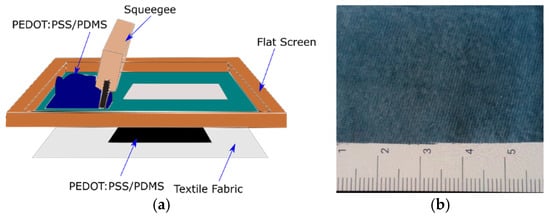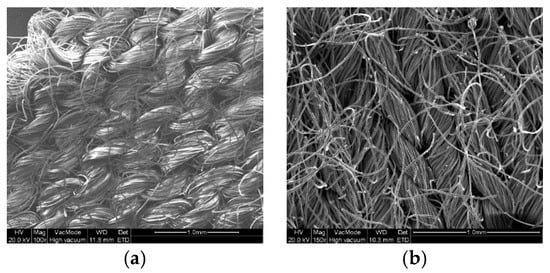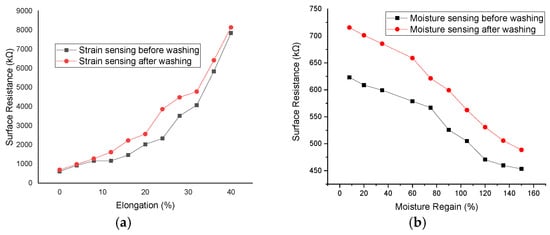Abstract
In this work, we have successfully developed a flexible, lightweight, and washable strain and moisture sensor textile fabric by printing poly(3,4-ethylenedioxythiophene) polystyrene sulfonate/polydimethylsiloxane-b-polyethylene oxide (PEDOT:PSS/PDMS) conductive polymer composite on knitted cotton fabric. A 60.2 kΩ/sq surface resistance has been obtained at a 30% ratio of PDMS to PEDOT:PSS at 0.012 g/cm2 solid add-on. The coated fabric was washed at 30 °C for 30 min in the presence of a standard detergent. It was observed that there was a 5.3% increase in surface resistance, i.e., 63.4 kΩ/sq. After coating, the fabric could still be stretched up to the infliction elongation of the fabric, i.e., 40%, with a significant change in surface resistance that makes it usable as a strain sensor. In addition, the conductive fabric showed a drop in surface resistance with an increase of the moisture regain up to 150%.
1. Introduction
Currently, textile materials are required to possess supplementary functionalities in addition to the standard comfort and durability capabilities, in line with the phenomenal growth of electronics and computing on the go [,]. Textile articles have attained all-embracing demand to construct flex, stretchy, and washable hardware in different domains such as an electrocardiograph (ECG) sensor [], an antenna [], and an energy harvesting device reported []. However, how a conductive polymer can be applied to conventional textiles without or with limited effect on their bulk properties in order to be utilized for a sensing function is still under investigation. For example, a textile-based strain sensor based on poly(3,4-ethylenedioxythiophene) polystyrene sulfonate (PEDOT:PSS) was reported by Zein et al. []. A dispersion solution of PEDOT:PSS was applied to a low-density polyethylene (LDPE) to produce a conductive LDPE that showed an electromechanical response during stretch. However, LDPE is highly hydrophobic and is not recommended for wearable applications. In addition, in that work, silicon was used as an agent, which has bio-compatibility issues. In this work, we therefore selected a biocompatible elastomer instead of the silicon, as well as a hydrophilic knitted cotton fabric, which make it suitable for wearable application. A PEDOT:PSS-based humidity sensor was also reported at the IEEE International Symposium on Antennas and Propagation and USNC/URSI National Radio Science Meeting []. The humidity sensor was incorporated in a patch antenna, which means that the substrate was thick and heavy in weight. Furthermore, only PEDOT:PSS was used; therefore, the flexibility was compromised. Being lightweight and flexible are among the prime interests in e-textiles. By using a conventional knitted fabric with good extensibility and moisture absorption, the application area of sensor is wider, even though the technique should also work on other textile substrates.
In this work, we have added polydimethylsiloxane-b-polyethylene oxide (PDMS) which compensates for the stiffness from PEDOT:PSS. Moreover, we have utilized a different conductive polymer composite of PEDOT:PSS, because of its acceptable electrical conductivity and flexibility [,], and PDMS, due to its biocompatibility and extensibility []. The result should be a single fabric that senses both strain and moisture. The aim of this work was to explore a homemade textile-based moisture and strain sensor via flat screen printing of PEDOT:PSS/PDMS conductive polymer composite on knitted cotton fabric. This type of sensor could have a typical use as humidity, sweat, stretch, swell, relaxation, and contraction detection in biomedical and sports applications.
2. Methodology and Results
A 140 GSM knitted white cotton fabric was used as a textile substrate. A high conductive grade poly(3,4-ethylenedioxythiophene) polystyrene sulfonate PH 1000 (PEDOT:PSS PH 1000) polymer obtained from Ossila, UK and polydimethylsiloxane-b-polyethylene oxide, methyl terminated (PDMS-b-PEO) elastomer obtained from Polysciences, UK were employed. The knitted cotton fabric was coated using 30% PDMS to PEDOT:PSS ratio via flat screen printing. A schematic view of the flat printing is shown in Figure 1a. Finally, the coated fabric was dried in an oven drier at 70 °C for 10 min and cured at 150 °C for 4 min to obtain the actual conductive fabric. The solid add-on was 0.012 g/cm2, which shows that the textile fabric does not lose its textile texture. An image of the actual coated fabric is shown in Figure 1b.

Figure 1.
(a) The coating of cotton fabric via screen printing, adopted from a previous study []; (b) actual poly(3,4-ethylenedioxythiophene) polystyrene sulfonate/polydimethylsiloxane-b-polyethylene oxide (PEDOT:PSS/PDMS) coated white cotton fabric.
A Mitutoyo Digimatic Indicator according to ISO 5084:1996(E) showed an increase in thickness from 0.5 mm to 0.65 mm. The bending length according to BS 3356:1990 test methods showed an increase from 2.45 cm to 2.65 cm and its respective flexural rigidity (1) increased from 206 to 484 mg cm.
where G = flexural rigidity (mg) cm, C = bending length (cm), and M = mass/area of specimen (g/m2).
An increase in tensile strength from 68.1 to 118 N and a drop in the strain at break from 113 to 87% were recorded according to ISO 13934-1 test method using an INSTRON universal strength tester. The FEI Quanta 200 FFE-SEM with an accelerating voltage of 20 kV showed a smoother fabric surface with less protruding yarn loops after the coating. The non-conductive samples were prepared prior to analysis by applying a gold coating using Balzers Union SKD 030 sputter coater. SEM images of the fabric before and after coating are shown in Figure 2.

Figure 2.
SEM results: (a), Knitted cotton fabric; (b) PEDOT:PSS/PDMS coated knitted cotton fabric.
A four-point probe measurement over different lengths showed a good washing resistance with a linear increase in the surface resistance of the PEDOT:PSS/PDMS coated knitted cotton fabric; the average surface resistances at five difference positions were 60.2 ± 0.089 (±0.15%) kΩ/sq before the wash and 63.408 ± 0.101 (±0.16%) kΩ/sq after the wash at 30 °C for 30 min in the presence of standard detergent. However the surface resistance after wash was significantly different from the unwashed fabric (f-ratio value of 2673.623 and p-value of <0.001 based on one-way ANOVA at a 95% confidence interval), it stayed yet conductive with strain and moisture dependent electrical resistance. The dependence of the electrical resistance on strain and moisture allows the fabric to be used as strain sensor. This was the case, and surface resistance of the conductive fabric increased from 60.2 kΩ/sq to 400 kΩ/sq at 40% elongation and dropped to 29.98 kΩ/sq at 100% moisture regain. The moisture regain was calculated by dividing the amount of water to the dry-weight of the fabric and then multiplied by 100 to express it in percentage.
A 2 × 5 cm2 PEDOT:PSS/PDMS coated textile-based electrode was constructed to test the dynamic response during stretching and moisture spreading. A stainless steel yarn was used as an interconnection between the textile-based electrode and an Arduino micro-controller. A resistance detection setup with the circuitry was established to test the strain and moisture detection separately. One end of the PEDOT:PSS/PDMS coated fabric was connected to 5 V of Arduino input and the other was connected in series to a 220 kΩ pull-down resistor, with the midpoint connected to the analog-to-digital converter of the Arduino. A schematic view of the established electrical circuitry setup is shown in Figure 3a. For the dynamic tests, the electrode was subjected to a continuous stretching from 0 to 40% elongation at 0.67 cm/s using a 3-7/8” MaxSteel Light Duty Drill Vise 83070 Stanley Hand Tool to study the stretch sense, while water was spread over the electrode surface at 1 mL/s using the bottle of Nano sprayer to study the moisture sensing. The data was transferred from the controller to data storage using the HC05 Bluetooth Module to make the setup portable. A 6 V battery was used to power the portable setup. The photographic pictures of the actual stretch and moisture sensing dynamic test using Arduino Nano are shown in Figure 3b,c, respectively.

Figure 3.
Dynamic tests: (a) Electrical circuitry establishment setup; (b) stretch; (c) moisture.
The strain sensitivity of the coated fabric was found to be reasonably stable with an increase from 0.61 kΩ to 8.26 kΩ at 40% elongation at 0.67 cm/s constant rate of stretching dynamic response. A graph of the effect of the dynamic stretching on surface resistance is shown in Figure 4a. The moisture regain sensitivity of the coated fabric was also reasonably stable showing a drop in the resistance from 0.62 kΩ to 0.46 kΩ when the moisture regain reached 150% at 1 mL/s rate of water spray. A graph of the effect of dynamic moisture regaining on resistance is shown in Figure 4b. In both the testing, the difference in percentage change of sheet resistance response to strain (0.0488 f-ratio and 0.828 p-value) and moisture (0.0583 f-ratio and 0.456 p-value) before and after washing was statistically insignificant based on one-way ANOVA at a 95% confidence level.

Figure 4.
Dynamic responses in sheet resistance: (a) Stretching; (b) moisture regaining.
These principles could be applied in medical applications, for instance, to determine the status of peripheral edema, where the increase in resistance indicates that edema is becoming severe, in sports applications, to detect the extent of sweat and positional movement of bicyclists, and at home, to sense urination of babies and elders, etc. Furthermore, the conductive fabric can be used for other wearable applications which need to be lightweight and flexible, and where washing is unavoidable.
3. Conclusions
In this work, we have successfully developed a washable conductive knitted cotton fabric by coating with PEDOT:PSS/PDMS via flat screen printing. The conductive fabric has been used to develop a strain and moisture sensors allowing washing, which provided fairly stable sensing stability up to 40% elongation and 150% moisture regain. The work has explored the use of conductive polymer composites to attain adequate flexibility and conductivity simultaneously. The developed sensor could have a potential application in detecting stretching for bicyclists, sweat and urine for babies and elders, and the extent of swelling in peripheral edema, etc.
Author Contributions
G.B.T. conceived the idea, conducted the experiment and wrote the paper; B.M. helped in conducting the experiment and edited the manuscript; K.A.F. and L.V.L. supervised and administrated the project. All authors have read and agreed to the published version of the manuscript.
Funding
The research and APC were funded by the NASCERE project 2018–2021.
Institutional Review Board Statement
Not applicable.
Informed Consent Statement
Not applicable.
Conflicts of Interest
The authors declare no conflict of interest.
References
- Tseghai, G.B.; Malengier, B.; Fante, K.A.; Van Langenhove, L. The Status of Textile-Based Dry EEG Electrodes. Autex Res. J. 2020. [Google Scholar] [CrossRef]
- Tseghai, G.B.; Malengier, B.; Fante, K.A.; Nigusse, A.B.; Langenhove, L.V. Integration of Conductive Materials with Textile Structures, an Overview. Sensors 2020, 20, 6910. [Google Scholar] [CrossRef] [PubMed]
- Tseghai, G.B.; Malengier, B.; Fante, K.A.; Nigusse, A.B.; Etana, B.B.; Van Langenhove, L. PEDOT:PSS/PDMS-Coated Cotton Fabric for ECG Electrode. In Proceedings of the 2020 IEEE International Conference on Flexible and Printable Sensors and Systems (FLEPS), Manchester, UK, 16–19 August 2020; pp. 1–4. [Google Scholar]
- Chen, S.J.; Fumeaux, C.; Chivers, B.; Shepherd, R. A 5.8-GHz Flexible Microstrip-Fed Slot Antenna Realized in PEDOT:PSS Conductive Polymer. In Proceedings of the 2016 IEEE International Symposium on Antennas and Propagation (APSURSI), Fajardo, PR, USA, 26 June–1 July 2016; pp. 1317–1318. [Google Scholar]
- He, T.; Shi, Q.; Wang, H.; Wen, F.; Chen, T.; Ouyang, J.; Lee, C. Beyond Energy Harvesting—Multi-Functional Triboelectric Nanosensors on a Textile. Nano Energy 2019, 57, 338–352. [Google Scholar] [CrossRef]
- El Zein, A.; Huppé, C.; Cochrane, C. Development of a Flexible Strain Sensor Based on PEDOT:PSS for Thin Film Structures. Sensors 2017, 17, 1337. [Google Scholar] [CrossRef] [PubMed]
- Abbasi, M.A.B.; Vryonides, P.; Nikolaou, S. Humidity Sensor Devices Using PEDOT:PSS. In Proceedings of the 2015 IEEE International Symposium on Antennas and Propagation & USNC/URSI National Radio Science Meeting, Vancouver, BC, Canada, 19–24 July 2015; pp. 1366–1367. [Google Scholar]
- Tseghai, G.B.; Mengistie, D.A.; Malengier, B.; Fante, K.A.; Van Langenhove, L. PEDOT:PSS-Based Conductive Textiles and Their Applications. Sensors 2020, 20, 1881. [Google Scholar] [CrossRef] [PubMed]
- Jin, S.; Sun, T.; Fan, Y.; Wang, L.; Zhu, M.; Yang, J.; Jiang, W. Synthesis of Freestanding PEDOT:PSS/PVA@Ag NPs Nanofiber Film for High-Performance Flexible Thermoelectric Generator. Polymer 2019, 167, 102–108. [Google Scholar] [CrossRef]
- Ionescu, M.; Winton, B.; Wexler, D.; Siegele, R.; Deslantes, A.; Stelcer, E.; Atanacio, A.; Cohen, D.D. Enhanced Biocompatibility of PDMS (Polydimethylsiloxane) Polymer Films by Ion Irradiation. Nucl. Instrum. Methods Phys. Res. Sect. B Beam Interact. Mater. At. 2012, 273, 161–163. [Google Scholar] [CrossRef]
- Tseghai, G.B.; Malengier, B.; Fante, K.A.; Nigusse, A.B.; Van Langenhove, L. Development of a Flex and Stretchy Conductive Cotton Fabric Via Flat Screen Printing of PEDOT:PSS/PDMS Conductive Polymer Composite. Sensors 2020, 20, 1742. [Google Scholar] [CrossRef] [PubMed]
Publisher’s Note: MDPI stays neutral with regard to jurisdictional claims in published maps and institutional affiliations. |
© 2021 by the authors. Licensee MDPI, Basel, Switzerland. This article is an open access article distributed under the terms and conditions of the Creative Commons Attribution (CC BY) license (https://creativecommons.org/licenses/by/4.0/).